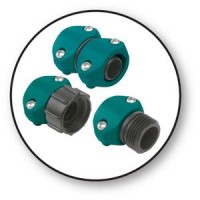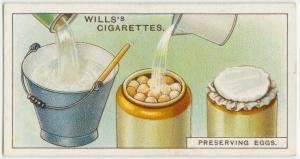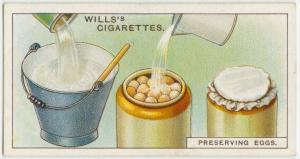These cards are super cool. They come from the New York Library Digital Collection and are British cigarette cards from the early 1900s.
 How to fix a hose
How to fix a hose
I remember repairing hose pipes when I was small. Everyone used to fix things back then, and the technique I learned was exactly as shown on this cigarette card. It made rolling the hosepipe up a bit tricky, but it sure worked! Nowadays you can get a coupler like the green one shown here.
Replacing a hose end or repairing a center section is a little more involved but still a simple job. The repair requires cutting the damaged section out and replacing with a mender. When cutting away damaged parts, make straight cuts with a sharp blade. To be certain you get the proper repair part, take the removed portion with you when purchasing the replacement. Repair part designs differ by manufacturer. Also make sure that the part you select is the correct one for your hose material, whether rubber or vinyl.


To make replacing fittings easier:
- Make sure the hose is clean and dry.
- Rub a little soap on the area you’re repairing to make it more pliable and easier to work with.
Step 1
Carefully cut out the damaged portion of the hose leaving the ends as square as possible.
Step 2
Loosen the screws on both sides of the replacement coupler.
Step 3
Insert the cut end of each section of hose into one side of the clamp mender. (Be sure they are fully inserted).
Step 4
Tighten the screws evenly until the clamp is tight enough to prevent the hose from being pulled out.
Step 5
Attach the hose to a sprinkler or nozzle, and turn on the water to test the connection. If water leaks out, tighten the connection until water no longer leaks out.
Keep eggs for up to 6 months
Water glassing eggs  would be a very useful skill to learn in the event of a major power outage. You must use sodium silicate and fresh, unwashed eggs kept in a solution of water glass will remain good for up to 6 months when properly collected and stored. This technique was used for centuries, especially for use during the winter months when hens laid less often because of
would be a very useful skill to learn in the event of a major power outage. You must use sodium silicate and fresh, unwashed eggs kept in a solution of water glass will remain good for up to 6 months when properly collected and stored. This technique was used for centuries, especially for use during the winter months when hens laid less often because of the longer, darker days.
the longer, darker days.
Water glass is alkaline in nature and tastes a bit like washing soda. It’s a clear, thick liquid that comes already made up. You can buy it from Amazon if your local hardware store doesn’t stock it.
If you want to try this, don’t use supermarket eggs. America is pretty much the only place that insists that eggs should be washed prior to selling. This is counterproductive. Eggs are naturally coated to prevent infections seeping through their porous shells and affecting the chickens. When eggs are washed, that coating is removed. In fact, the card here suggests that you slightly greas e your eggs with a little butter to doubly insulate the eggs. Remember, one bad egg will spoil the barrel.
e your eggs with a little butter to doubly insulate the eggs. Remember, one bad egg will spoil the barrel.

